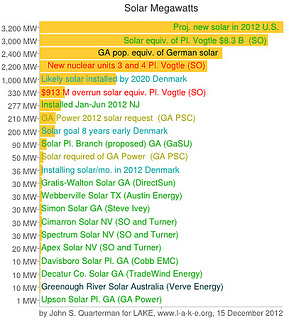Solar power is going so well worldwide that Deutsche Bank has just increased its projections for global demand, noting that India and Italy have already in 2013 reached grid parity without subsidies with other sources of energy, and it expects the rest of the world to follow as early as 2014. The big winner is rooftop solar. Is Georgia paying attention?
Becky Beetz wrote for Global PV 26 February 2013, Deutsche Bank: Sustainable solar market expected in 2014,
Buoyed by bullish demand forecasts, and increasing utilization rates and pricing, Deutsche Bank forecasts a solar market transition from subsidized to sustainable in 2014. Italy REC solar photovoltaic plant
The German bank has raised its 2013 global solar demand forecast to 30 GW — representing a 20% year-on-year increase — on the back of suggestions of strong demand in markets including India, the U.S., China (around 7 to 10 GW), the U.K. (around 1 to 2 GW), Germany and Italy (around 2 GW).
Rooftop installations are, in particular, expected to be a main focus, says Deutsche Bank. A trend for projects being planned with either “minimal/no incentives” has also been observed, despite the belief that solar policy outlooks are improving, particularly in the U.S., China and India, and “other emerging markets”.
More analysis by Jeff Spross in ThinkProgress 3 March 2013, Solar Report Stunner: Unsubsidized ‘Grid Parity Has Been Reached In India’, Italy–With More Countries Coming in 2014.
As Renew Economy also points out, this is the third report in the past month
anticipating a bright future for the global solar market: UBS released a report that concluded an “unsubsidized solar revolution” was in the works, “Thanks to significant cost reductions and rising retail tariffs, households and commercial users are set to install solar systems to reduce electricity bills – without any subsidies.” And Macquarie Group argued that costs for rooftop solar in Germany have fallen so far that even with subsidy cuts “solar installations could continue at a torrid pace.”
Here in America, solar power installations boomed over the course of 2011 and 2012, even as the price of solar power systems continued to plunge. To a large extent, the American solar boom has been driven by third party leasing agreements — which are heavily involved in rooftop installation.
Meanwhile, on the international scene, the cost of manufacturing solar panels in China is expected to drop to an all-new low of 42 cents per watt in 2015, and power generated from solar is predicted to undercut that produced by both coal and most forms of natural gas within a decade.
Solar already beats natural gas and coal when you figure in that solar requires no fuel.
 Maybe Georgia Power and Southern Company will finally get the message
and
stop the nuclear boondoggle.
Imagine how much solar power Georgia Power could have already deployed
for what they have already billed customers for power nobody has gotten
from the new nukes!
Google already bought almost as much renewable solar and wind power
as Vogtle 3 and 4 are supposed to produce, and Google spent less.
Maybe Georgia Power and Southern Company will finally get the message
and
stop the nuclear boondoggle.
Imagine how much solar power Georgia Power could have already deployed
for what they have already billed customers for power nobody has gotten
from the new nukes!
Google already bought almost as much renewable solar and wind power
as Vogtle 3 and 4 are supposed to produce, and Google spent less.
It’s not too late for Georgia to get moving on the huge solar economic
potential for our state
spelled out by ASU two years ago.
Georgia Power can lead Georgia and Southern Company can lead
the southeast in leading the country to a real renewable future.
 It’s time to choose:
continue to drag us behind,
or become a leader in jobs and economic development in clean energy in the south.
It’s time to choose:
continue to drag us behind,
or become a leader in jobs and economic development in clean energy in the south.
-jsq
Short Link: